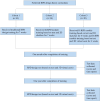Efficacy of a Virtual 3D Simulation-Based Digital Training Module for Building Dental Technology Students' Long-Term Competency in Removable Partial Denture Design: Prospective Cohort Study
- PMID: 38596827
- PMCID: PMC11009623
- DOI: 10.2196/46789
Efficacy of a Virtual 3D Simulation-Based Digital Training Module for Building Dental Technology Students' Long-Term Competency in Removable Partial Denture Design: Prospective Cohort Study
Erratum in
-
Correction: Efficacy of a Virtual 3D Simulation-Based Digital Training Module for Building Dental Technology Students' Long-Term Competency in Removable Partial Denture Design: Prospective Cohort Study.JMIR Serious Games. 2024 Aug 19;12:e63113. doi: 10.2196/63113. JMIR Serious Games. 2024. PMID: 39166437 Free PMC article. No abstract available.
Abstract
Background: Removable partial denture (RPD) design is crucial to long-term success in dental treatment, but shortcomings in RPD design training and competency acquisition among dental students have persisted for decades. Digital production is increasing in prevalence in stomatology, and a digital RPD (D-RPD) module, under the framework of the certified Objective Manipulative Skill Examination of Dental Technicians (OMEDT) system reported in our previous work, may improve on existing RPD training models for students.
Objective: We aimed to determine the efficacy of a virtual 3D simulation-based progressive digital training module for RPD design compared to traditional training.
Methods: We developed a prospective cohort study including dental technology students at the Stomatology College of Chongqing Medical University. Cohort 1 received traditional RPD design training (7 wk). Cohort 2 received D-RPD module training based on text and 2D sketches (7 wk). Cohort 3 received D-RPD module pilot training based on text and 2D sketches (4 wk) and continued to receive training based on 3D virtual casts of real patients (3 wk). RPD design tests based on virtual casts were conducted at 1 month and 1 year after training. We collected RPD design scores and the time spent to perform each assessment.
Results: We collected the RPD design scores and the time spent to perform each assessment at 1 month and 1 year after training. The study recruited 109 students, including 58 (53.2%) female and 51 male (56.8%) students. Cohort 1 scored the lowest and cohort 3 scored the highest in both tests (cohorts 1-3 at 1 mo: mean score 65.8, SD 21.5; mean score 81.9, SD 6.88; and mean score 85.3, SD 8.55, respectively; P<.001; cohorts 1-3 at 1 y: mean score 60.3, SD 16.7; mean score 75.5, SD 3.90; and mean score 90.9, SD 4.3, respectively; P<.001). The difference between cohorts in the time spent was not statistically significant at 1 month (cohorts 1-3: mean 2407.8, SD 1370.3 s; mean 1835.0, SD 1329.2 s; and mean 1790.3, SD 1195.5 s, respectively; P=.06) but was statistically significant at 1 year (cohorts 1-3: mean 2049.16, SD 1099.0 s; mean 1857.33, SD 587.39 s; and mean 2524.3, SD 566.37 s, respectively; P<.001). Intracohort comparisons indicated that the differences in scores at 1 month and 1 year were not statistically significant for cohort 1 (95% CI -2.1 to 13.0; P=.16), while cohort 3 obtained significantly higher scores 1 year later (95% CI 2.5-8.7; P=.001), and cohort 2 obtained significantly lower scores 1 year later (95% CI -8.8 to -3.9; P<.001).
Conclusions: Cohort 3 obtained the highest score at both time points with retention of competency at 1 year, indicating that progressive D-RPD training including virtual 3D simulation facilitated improved competency in RPD design. The adoption of D-RPD training may benefit learning outcomes.
Keywords: CAD; RPD; assessment; clinical practice; cohort study; computer-aided design; dental technology; dentistry; design; digital training; efficacy; removable partial denture; training; treatment; virtual; virtual simulation.
© KeXin Liu, YaQian Xu, ChaoYi Ma, Na Yu, FaBing Tan, Yi Li, YaXin Bai, XiaoMing Fu, JiaWu Wan, DongQi Fan, HuBin Yin, MeiXi Chen, HongJi Chen, Lin Jiang, JinLin Song, Ping Ji, XiaoHan Zhao, MengWei Pang. Originally published in JMIR Serious Games (https://games.jmir.org).
Conflict of interest statement
Figures



Similar articles
-
Preliminary User Evaluation of a New Dental Technology Virtual Simulation System: Development and Validation Study.JMIR Serious Games. 2022 Sep 12;10(3):e36079. doi: 10.2196/36079. JMIR Serious Games. 2022. PMID: 36094803 Free PMC article.
-
Correction: Efficacy of a Virtual 3D Simulation-Based Digital Training Module for Building Dental Technology Students' Long-Term Competency in Removable Partial Denture Design: Prospective Cohort Study.JMIR Serious Games. 2024 Aug 19;12:e63113. doi: 10.2196/63113. JMIR Serious Games. 2024. PMID: 39166437 Free PMC article. No abstract available.
-
Enhancing Student Learning in Removable Partial Denture Design by Using Virtual Three-Dimensional Models Versus Traditional Two-Dimensional Drawings: A Comparative Study.J Prosthodont. 2019 Oct;28(8):927-933. doi: 10.1111/jopr.13099. Epub 2019 Aug 16. J Prosthodont. 2019. PMID: 31343801
-
Virtual reality simulation training for health professions trainees in gastrointestinal endoscopy.Cochrane Database Syst Rev. 2018 Aug 17;8(8):CD008237. doi: 10.1002/14651858.CD008237.pub3. Cochrane Database Syst Rev. 2018. PMID: 30117156 Free PMC article.
-
Evaluation of the methods for determining accuracy of fit and precision of RPD framework in Digital (3D printed, milled) and conventional RPDs - a systematic review.BMC Oral Health. 2024 Dec 4;24(1):1466. doi: 10.1186/s12903-024-05262-x. BMC Oral Health. 2024. PMID: 39633297 Free PMC article.
Cited by
-
Use of virtual simulation for regenerative endodontic training: randomized controlled trial.BMC Med Educ. 2025 Feb 17;25(1):254. doi: 10.1186/s12909-025-06808-5. BMC Med Educ. 2025. PMID: 39962452 Free PMC article. Clinical Trial.
References
-
- Bhathal M, Batra J, Attresh G, Sambyal S. A review on stresses-induced by removable partial dentures. Int J Contemp Dent Med Rev. 2015:050115. doi: 10.15713/ins.ijcdmr.56. doi. - DOI
LinkOut - more resources
Full Text Sources
Miscellaneous

